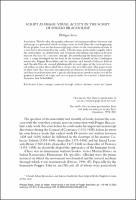Chapter Script as Image: Visual Acuity in the Script of Poggio Bracciolini
| dc.contributor.author | Sissis, Philippa | |
| dc.date.accessioned | 2022-06-01T12:17:07Z | |
| dc.date.available | 2022-06-01T12:17:07Z | |
| dc.date.issued | 2020 | |
| dc.identifier | ONIX_20220601_9788864539683_423 | |
| dc.identifier.issn | 2704-6230 | |
| dc.identifier.uri | https://library.oapen.org/handle/20.500.12657/56240 | |
| dc.description.abstract | The fact that the graphic substance of writing oscillates between text and image is a potential which writing carries in itself from the very beginning. Every graphic trace on the manuscript page relates to the conventions of time in a way that is determined by the scribe. This becomes particularly tangible when the conventions are deliberately and systematically broken and replaced by new ones on the basis of a concrete concept. By introducing the humanistic minuscule, a script developed on the basis of the historical model of the Carolingian minuscule, Poggio Bracciolini and his mentors and friends Coluccio Salutati and Niccolò Niccoli, created philologically revised copies of the texts of classical authors in what they called littera antiqua, the new old script. This paper wants to show how the conscious incorporation of elements of historical manuscripts and their transformation into a specifically humanistic product makes use of the graphical potential of script and mise-en-page in order to translate a humanistic discourse into SchriftBild. | |
| dc.language | English | |
| dc.relation.ispartofseries | Atti | |
| dc.subject.other | Littera antiqua | |
| dc.subject.other | iconicity of script | |
| dc.subject.other | artifact | |
| dc.subject.other | rhetoric | |
| dc.subject.other | visual arts | |
| dc.subject.other | layout | |
| dc.title | Chapter Script as Image: Visual Acuity in the Script of Poggio Bracciolini | |
| dc.type | chapter | |
| oapen.identifier.doi | 10.36253/978-88-6453-968-3.10 | |
| oapen.relation.isPublishedBy | bf65d21a-78e5-4ba2-983a-dbfa90962870 | |
| oapen.relation.isbn | 9788864539683 | |
| oapen.series.number | 38 | |
| oapen.pages | 30 | |
| oapen.place.publication | Florence |

